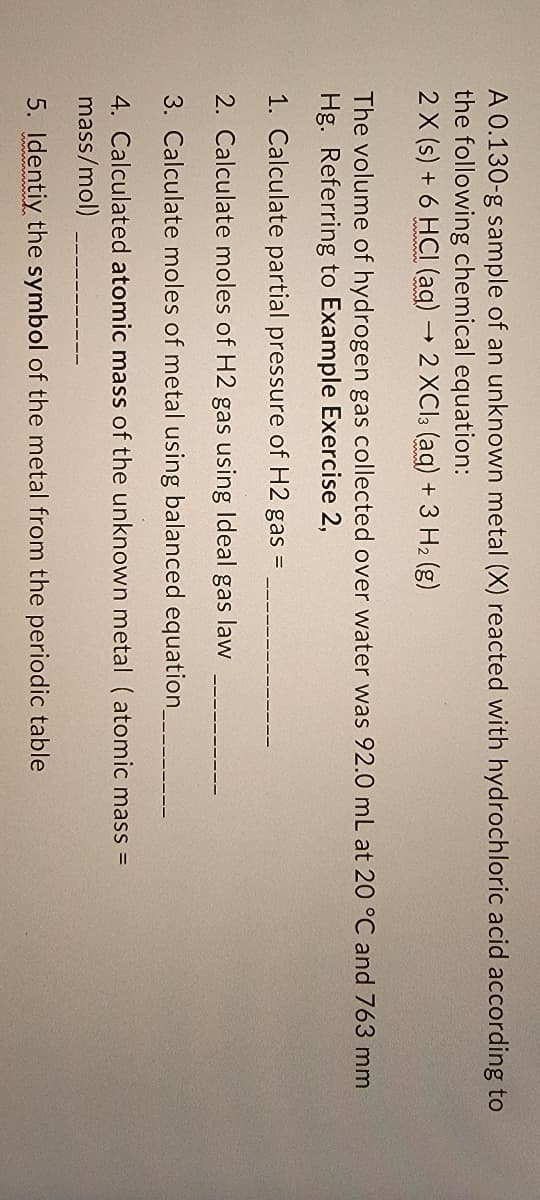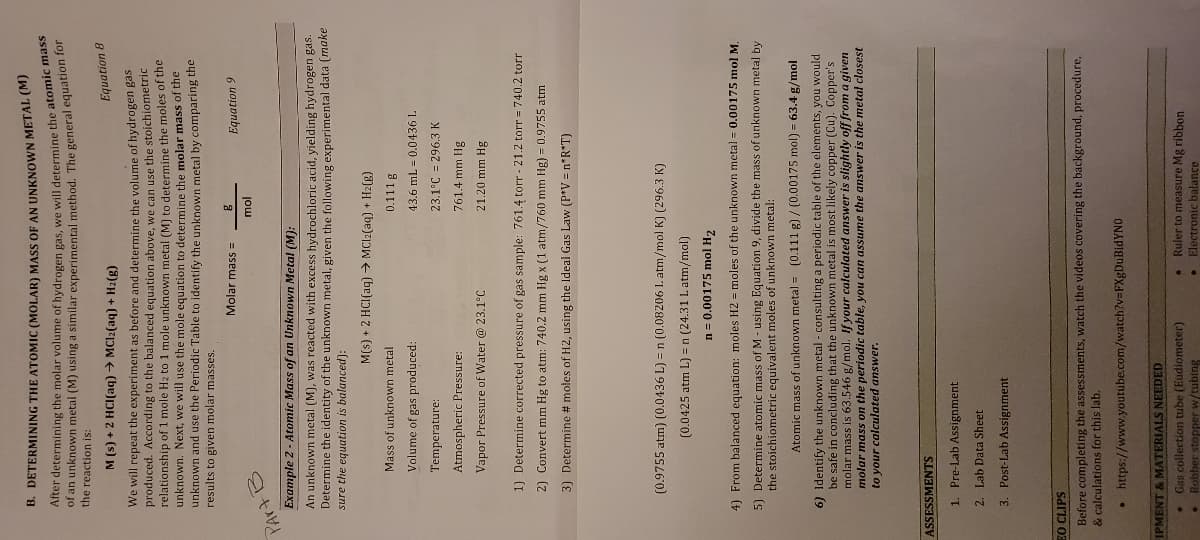A 0.130-g sample of an unknown metal (X) reacted with hydrochloric acid according to the following chemical equation: 2 X (s) + 6 HCI (ag) 2 XCI3 (ag) + 3 H2 (g) The volume of hydrogen gas collected over water was 92.0 mL at 20 °C and 763 mm Hg. Referring to Example Exercise 2, 1. Calculate partial pressure of H2 gas = 2. Calculate moles of H2 gas using Ideal gas law 3. Calculate moles of metal using balanced equation
A 0.130-g sample of an unknown metal (X) reacted with hydrochloric acid according to the following chemical equation: 2 X (s) + 6 HCI (ag) 2 XCI3 (ag) + 3 H2 (g) The volume of hydrogen gas collected over water was 92.0 mL at 20 °C and 763 mm Hg. Referring to Example Exercise 2, 1. Calculate partial pressure of H2 gas = 2. Calculate moles of H2 gas using Ideal gas law 3. Calculate moles of metal using balanced equation
Chemistry: An Atoms First Approach
2nd Edition
ISBN:9781305079243
Author:Steven S. Zumdahl, Susan A. Zumdahl
Publisher:Steven S. Zumdahl, Susan A. Zumdahl
Chapter8: Gases
Section: Chapter Questions
Problem 27Q
Related questions
Question

Transcribed Image Text:A 0.130-g sample of an unknown metal (X) reacted with hydrochloric acid according to
the following chemical equation:
2 X (s) + 6 HCI (ag) 2 XCI3 (ag) + 3 H2 (g)
The volume of hydrogen gas collected over water was 92.0 mL at 20 °C and 763 mm
Hg. Referring to Example Exercise 2,
1. Calculate partial pressure of H2 gas =
2. Calculate moles of H2 gas using Ideal gas law
3. Calculate moles of metal using balanced equation_
4. Calculated atomic mass of the unknown metal (atomic mass =
mass/mol)
5. Identiy the symbol of the metal from the periodic table

Transcribed Image Text:B. DETERMINING THE ATOMIC (MOLAR) MASS OF AN UNKNOWN METAE
After determining the molar volume of hydrogen gas, we will determine the atomne for
of an unknown metal (M) using a similar experimental method. The general equation te
the reaction is:
M (s) + 2 HCI(aq) → MCI2(aq) + H2(g)
Equation 8
We will repeat the experiment as before and determine the volume of hydrogen Bar
produced. According to the balanced equation above, we can use the stoichiometne
relationship of 1 mole H2 to 1 mole unknown metal (M) to determine the moles of uhe
unknown. Next, we will use the mole equation to determine the molar mass of the
unknown and use the Periodic Table to identify the unknown metal by comparing the
results to given molar masses.
Molar mass =
Equation 9
mol
Example 2 - Atomic Mass of an Unknown Metal (M):
An unknown metal (M), was reacted with excess hydrochloric acid, yielding hydrogen gas.
Determine the identity of the unknown metal, given the following experimental data (make
sure the equation is balanced):
M(s) + 2 HCI(aq) → MCI2(aq) + H2(B)
Mass of unknown metal
0.111 g
Volume of gas produced:
43.6 mL 0.0436 L
Temperature:
23.1°C = 296.3 K
Atmospheric Pressure:
761.4 mm Hg
Vapor Pressure of Water @ 23.1°C
21.20 mm Hg
1) Determine corrected pressure of gas sample: 761.4 torr - 21.2 torr = 740.2 torr
2) Convert mm Hg to atm: 740.2 mm Hg x (1 atm/760 mm Hg) = 0.9755 atm
3) Determine # moles of H2, using the Ideal Gas Law (P*V = n*R*T)
(0.9755 atm) (0.0436 L) = n (0.08206 L atm/mol K) (296.3 K)
(0.0425 atm L) = n (24.31 L atm/mol)
n = 0.00175 mol H2
4) From balanced equation: moles H2 = moles of the unknown metal 0.00175 mol M,
5) Determine atomic mass of M - using Equation 9, divide the mass of unknown metal by
the stoichiometric equivalent moles of unknown metal:
Atomic mass of unknown metal = (0.111 g) / (0.00175 mol) = 63.4 g/mol
6) Identify the unknown metal - consulting a periodic table of the elements, you would
be safe in concluding that the unknown metal is most likely copper (Cu). Copper's
molar mass is 63.546 g/mol. If your calculated answer is slightly off from a given
molar mass on the periodic table, you can assume the answer is the metal closest
to your calculated answer.
ASSESSMENTS
1. Pre-Lab Assignment
2. Lab Data Sheet
3. Post-Lab Assignment
EO CLIPS
Before completing the assessments, watch the videos covering the background, procedure,
& calculations for this lab.
• https://www.youtube.com/watch?v=FXgDuBidYNO
IPMENT & MATERIALS NEEDED
• Gas collection tube (Eudiometer)
• Robber stopper w/tubing
Ruler to measure Mg ribbon
• Electronic balance
Expert Solution
This question has been solved!
Explore an expertly crafted, step-by-step solution for a thorough understanding of key concepts.
This is a popular solution!
Trending now
This is a popular solution!
Step by step
Solved in 2 steps with 2 images

Knowledge Booster
Learn more about
Need a deep-dive on the concept behind this application? Look no further. Learn more about this topic, chemistry and related others by exploring similar questions and additional content below.Recommended textbooks for you

Chemistry: An Atoms First Approach
Chemistry
ISBN:
9781305079243
Author:
Steven S. Zumdahl, Susan A. Zumdahl
Publisher:
Cengage Learning


Chemistry
Chemistry
ISBN:
9781305957404
Author:
Steven S. Zumdahl, Susan A. Zumdahl, Donald J. DeCoste
Publisher:
Cengage Learning

Chemistry: An Atoms First Approach
Chemistry
ISBN:
9781305079243
Author:
Steven S. Zumdahl, Susan A. Zumdahl
Publisher:
Cengage Learning


Chemistry
Chemistry
ISBN:
9781305957404
Author:
Steven S. Zumdahl, Susan A. Zumdahl, Donald J. DeCoste
Publisher:
Cengage Learning

Chemistry for Engineering Students
Chemistry
ISBN:
9781337398909
Author:
Lawrence S. Brown, Tom Holme
Publisher:
Cengage Learning

General Chemistry - Standalone book (MindTap Cour…
Chemistry
ISBN:
9781305580343
Author:
Steven D. Gammon, Ebbing, Darrell Ebbing, Steven D., Darrell; Gammon, Darrell Ebbing; Steven D. Gammon, Darrell D.; Gammon, Ebbing; Steven D. Gammon; Darrell
Publisher:
Cengage Learning

Physical Chemistry
Chemistry
ISBN:
9781133958437
Author:
Ball, David W. (david Warren), BAER, Tomas
Publisher:
Wadsworth Cengage Learning,